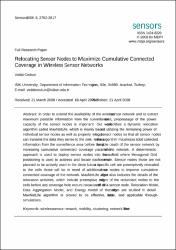Relocating sensor nodes to maximize cumulative connected coverage in wireless sensor networks
Künye
Coşkun, V. (2008). Relocating sensor nodes to maximize cumulative connected coverage in wireless sensor networks. Sensors, 8(4), 2792-2817. doi:10.3390/s8042792Özet
In order to extend the availability of the wireless sensor network and to extract maximum possible information from the surveillance area, proper usage of the power capacity of the sensor nodes is important. Our work describes a dynamic relocation algorithm called MaxNetLife, which is mainly based on utilizing the remaining power of individual sensor nodes as well as properly relocating sensor nodes so that all sensor nodes can transmit the data they sense to the sink. Hence, the algorithm maximizes total collected information from the surveillance area before the possible death of the sensor network by increasing cumulative connected coverage parameter of the network. A deterministic approach is used to deploy sensor nodes into the sensor field where Hexagonal Grid positioning is used to address and locate each sensor node. Sensor nodes those are not planned to be actively used in the close future in a specific cell are preemptively relocated to the cells those will be in need of additional sensor nodes to improve cumulative connected coverage of the network. MaxNetLife algorithm also includes the details of the relocation activities, which include preemptive migration of the redundant nodes to the cells before any coverage hole occurs because of death of a sensor node. Relocation Model, Data Aggregation Model, and Energy model of the algorithm are studied in detail. MaxNetLife algorithm is proved to be effective, scalable, and applicable through simulations.
Kaynak
SensorsCilt
8Sayı
4İlgili Öğeler
Başlık, yazar, küratör ve konuya göre gösterilen ilgili öğeler.
-
Cluster based sensor scheduling in a target tracking application with particle filtering
Özfidan, Özgür; Bayazıt, Uluğ; Çırpan, Hakan Ali (IEEE, 2007)In multi-sensor applications management of sensors is necessary for the classification of data they produce and for the efficient use of sensors as well. One of the important aspects in sensor management is the sensor ... -
Range sensing with a Scheimpflug camera and a CMOS sensor/processor chip
Çilingiroğlu, Uğur; Chen, Sicheng; Çilingiroğlu, Emre (IEEE-INST Electrical Electronics Engineers Inc, 2004-02)An image-based range-sensing technique is presented. The technique is originally considered for highway collision avoidance applications, but its generality makes it suitable for application in robotics, manufacturing, and ... -
Parçacık süzgeçleme ile hedef izleme uygulamasında topak çizelgeleme
Özfidan, Özgür; Bayazıt, Uluğ; Çırpan, Hakan Ali (IEEE, 2007)Bu çalışmada, uzaklık ölçer algılayıcılarla hedef takibi uygulamasında algılayıcı çizelgeleme problemi ele alınmıştır. Çok algılayıcılı uygulamalarda algılayıcıların yönetimi ürettikleri verilerin sınıflandırılması için ...


















